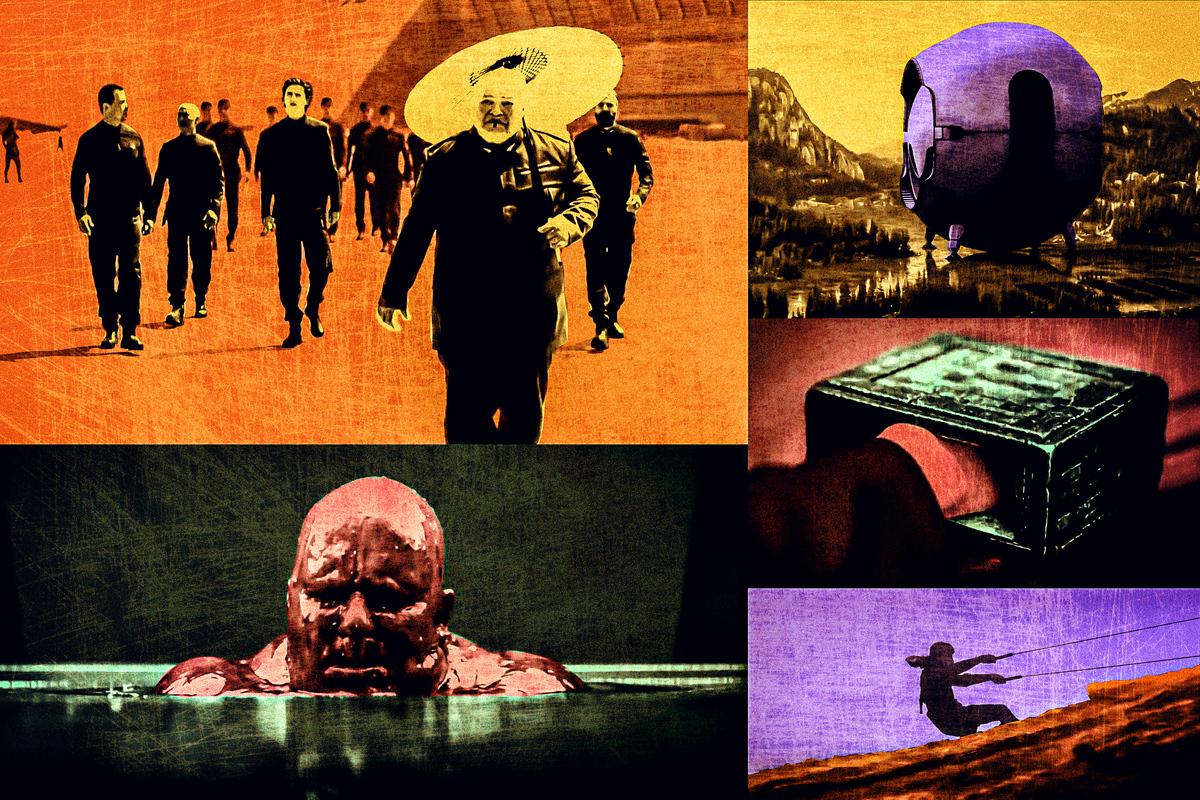
Our long national nightmare is almost over. After being moved from its original October 2023 release date due to the Hollywood labor strikes, Dune: Part Two finally arrives in theaters this weekend. In an alternate timeline, Denis Villeneuve’s highly anticipated sequel could’ve been brushing shoulders with fellow heavyweights Barbie and Oppenheimer at this year’s Academy Awards; instead, it’s positioned to be the first (and biggest?) must-see cinematic event of 2024. If the first Dune made over $400 million despite being simultaneously available to stream on HBO Max, you can bet that Part Two will have an absolute feast at the box office.
Anyone familiar with Frank Herbert’s 1965 novel will know what they’re getting with Part Two—one of the joys for book-readers is seeing how their favorite moments from the page come to life on screen. But for moviegoers like myself who are going into the sequel with minimal knowledge of the source material, the tantalizing aspect of Part Two is the unknown: discovering what events from the first film could lead to exciting payoffs. (At CinemaCon last year, Villeneuve teased that Part Two will be an “action-packed, epic war movie” shot entirely with IMAX cameras, as if the hype levels for this thing weren’t already at a 10.)
For fellow non-book-readers, I present this unofficial primer for Part Two: a breakdown of 12 crucial moments from the first Dune and some totally uneducated guesses about what they could mean for the sequel. Without further ado, let’s harness some desert power.
The Bene Gesserit and Paul’s Prophecy
While there are powerful families in the world of Dune—House Atreides and House Harkonnen get much of the spotlight—the real X factor is the Bene Gesserit, a mysterious sisterhood with abilities that cause people to liken them to witches. (We’ll address “the Voice” shortly.) The Bene Gesserit prefer to operate in the shadows and think about the bigger picture: As the very intimidating Reverend Mother Mohiam (Charlotte Rampling) explains in Dune, their plans are best measured in centuries. That includes a selective breeding program to bring about the Kwisatz Haderach, a male heir who would not only wield the clan’s powers, but be able to see into the future.
Our young protagonist, Paul Atreides (Timothée Chalamet), is believed to be the Kwisatz Haderach; his mother, Lady Jessica (Rebecca Ferguson), is a member of the Bene Gesserit who went against the sisterhood’s wishes and gave birth to a son. (Yes, Bene Gesserit can control what sex their babies will be, which is a lawful good if it means nobody in this universe can host ill-advised gender-reveal parties.) From Neo to Harry Potter to Luke Skywalker, chosen-one narratives are a popular trope in science fiction and fantasy. On the surface, Dune is no exception, but one has to wonder whether Paul is actually a child of destiny or whether he’s been duped by the very propaganda preceding his arrival on the desert planet Arrakis. After all, the Bene Gesserit have long planted the seeds for the Fremen to believe Paul is their savior—the Mahdi—and his journey on Arrakis could be a matter of circumstance as much as the fulfillment of an ancient prophecy.
What do the Bene Gesserit really want, and will Lady Jessica act in the best interests of her son or her sisterhood? Hopefully those answers will arrive in Part Two.
“Use the Voice”
Perhaps the most impressive thing the Bene Gesserit are capable of is wielding “the Voice,” which essentially allows the user to control others by modulating their voice to sound like the distant cousin of Tom Hardy’s Venom. Since Paul is still learning how to use his powers, he begins Dune as something of a novice with the Voice, but it’s easy to see how dangerous it can be in the wrong hands. (To break free from their Harkonnen captors toward the end of the film, Lady Jessica orders one of the soldiers to kill his comrade.) Most importantly, though, the Voice blessed us with a wonderful meme template.
The Pain Box
Thankfully, the Bene Gesserit have devised a test to ensure anyone with those abilities is in control of their impulses. As the Reverend Mother wields a poison-tipped needle at his neck, Paul must stick his hand in a box capable of inflicting unimaginable pain—the Reverend Mother demands that he keep his hand inside; otherwise, she’ll kill him. It’s one of the most arresting sequences of Dune: an early moment that shows what Paul could be capable of once he’s mastered his abilities. Even the Reverend Mother looks intimidated:

I don’t imagine the pain box will return in the sequel—it feels like the Dune equivalent of the Hogwarts Sorting Hat; you save it for special occasions!—but as the first step on Paul’s journey to possible messiah status, it’s well worth remembering.
Shots of Giant Ships Slowly Taking Off and Landing
Villeneuve is one of the most exciting filmmakers working in science fiction: an auteur who took on the seemingly insurmountable tasks of making a sequel to Blade Runner and adapting Dune, and he came out on the other side with overwhelming acclaim. (David Lynch’s Dune has its merits, but even he largely disowned the movie.) When it comes to big-budget sci-fi, there are several reasons Villeneuve is the right man for the job: He excels at world-building and creating a sense of scale that most blockbusters never achieve. He also understands that the coolest things you can show an audience in these kinds of films are shots of giant ships slowly taking off and landing:
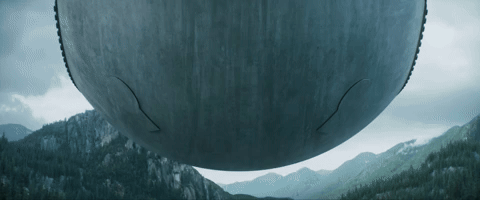
As someone who lives and breathes science fiction, I find these moments to be as tranquil as a Japanese rock garden:
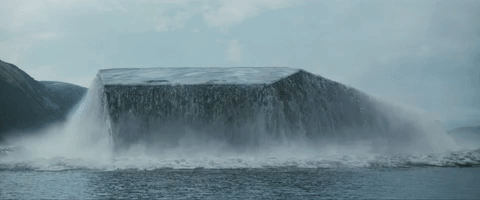
With Dune: Part Two, there’s no need for Villeneuve to deviate from a winning formula. Give the people what they want: extremely expensive-looking landing procedures on alien planets.
Stephen McKinley Henderson’s Dainty Umbrella
I know what you’re thinking: The only way to survive the punishing conditions on Arrakis is by wearing a Fremen stillsuit, which uses every drop of sweat to replenish your body’s fluids in the sweltering heat. But is your survival on a hostile planet as important as pulling off an iconic look? I present to you Stephen McKinley Henderson’s Thufir Hawat, with the greatest fashion statement in the universe:
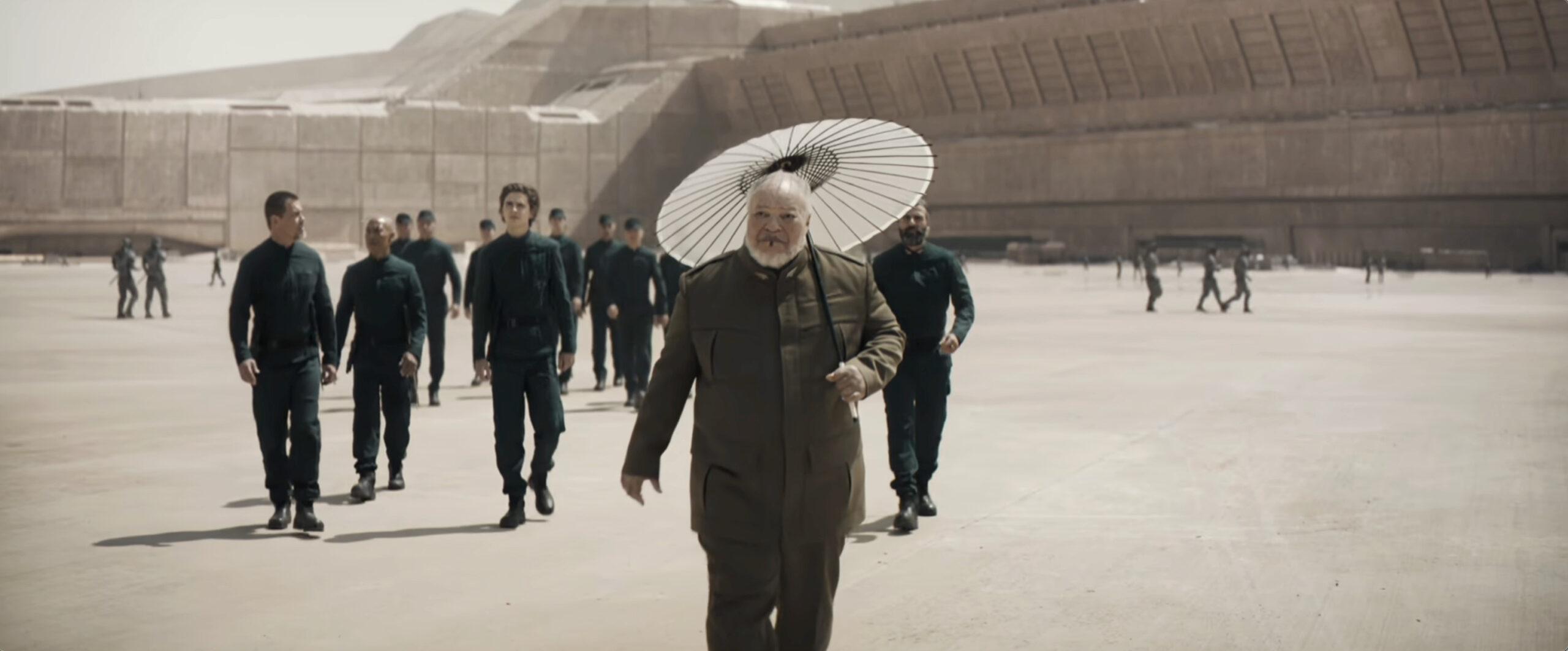
I love this parasol, and I love that someone on set offered it to Henderson to protect him from the sun before Villeneuve decided his character should just carry it around. If the parasol isn’t back for the sequel, there will be hell to pay.
The Fall of House Atreides
Like the ill-fated House Stark in Game of Thrones, House Atreides is admired for its honor and sense of duty, which compels the family patriarch, Leto Atreides (Oscar Isaac), to accept the Emperor’s assignment to become the new fief-holder on Arrakis. Of course, the whole thing was an elaborate ploy by the Emperor and House Harkonnen to destroy House Atreides, which basically goes through its own version of the Red Wedding. In a dead-of-night siege, the Atreides military is all but wiped out, while Leto is incapacitated by Dr. Wellington Yueh (Chang Chen), who betrays his sovereign because Baron Harkonnen (Stellan Skarsgard) is holding his wife captive. Only a handful of characters, including Paul and Lady Jessica, survive the deadly siege. Suffice it to say, avenging House Atreides will be at the top of Paul’s mind in the sequel.
The Fall of Leto Atreides’s Clothing
With House Atreides all but defeated, Baron Harkonnen rubs it in Leto’s face by having his paralyzed adversary laid out in nude repose at the end of a comically massive dining table. While the scene carries a lot of significance, it’s impossible not to be distracted by the sight of a naked Oscar Isaac, someone who has been hailed by multiple publications as the sexiest man alive. (No lies detected. Have you seen the way this dude eats Cheetos?) Out of context, this would make for a steamy magazine spread:
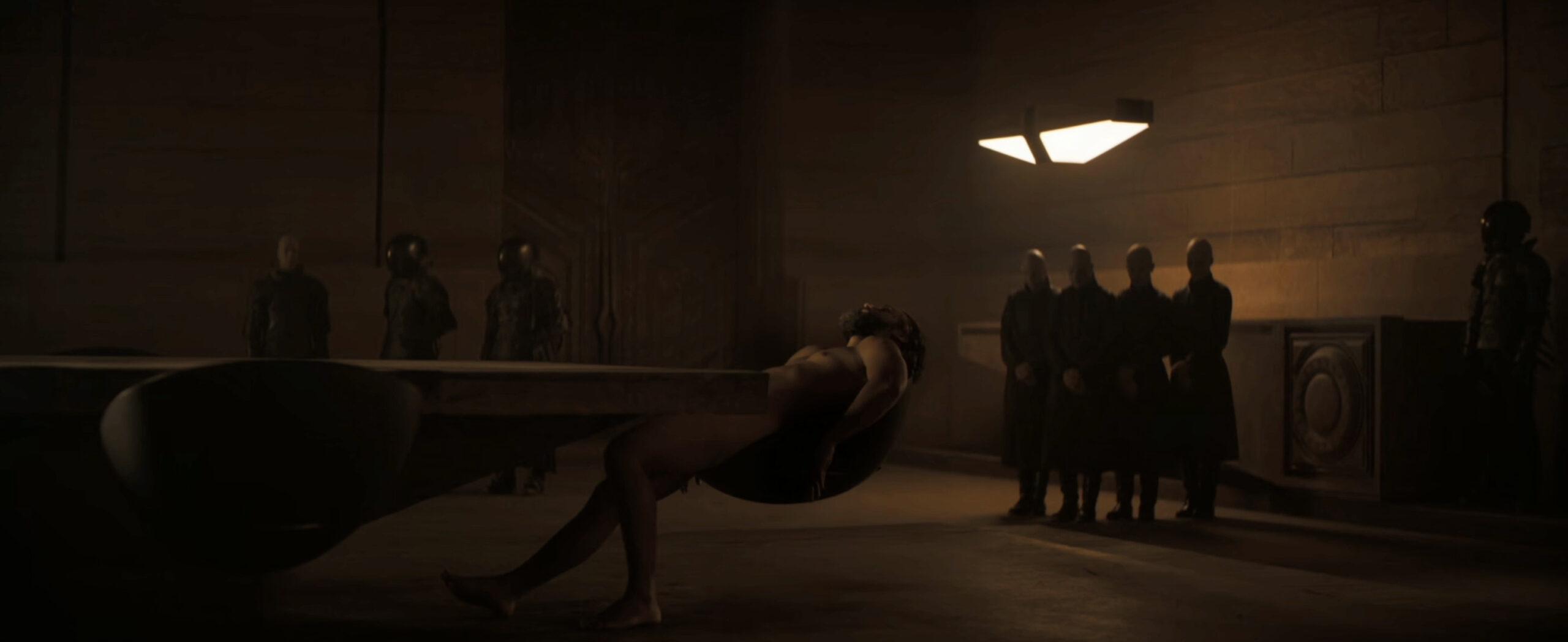
But even as he accepts his fate, Leto does get one final moment of revenge. Dr. Yueh inserted a false tooth in Leto’s mouth that releases a poisonous gas, which he uses at an opportune moment to poison the Baron. Unless there’s some kind of prologue or flashback sequence, Leto won’t be back for the sequel, but we’ll always have his memorable death scene. As for Villeneuve, Leto will always be with the director in spirit—because Isaac gifted him the cock sock he used in the character’s final moments.
Baron Harkonnen’s Oil Bath
Alas, while Leto’s poison capsule grievously harms the Baron, it’s not enough to kill him. After the Baron survives the attack by hanging onto the dining room ceiling like an overweight vampire bat, he soaks in what appears to be a giant vat of oil as a form of healing. A restorative spa treatment may not seem like the most crucial thing to remember from Dune, but consider that Stellan Skarsgard loved being naked on the set and actually requested more scenes where the Baron is nude because he felt the character looked more frightening that way. (If only Oscar Isaac requested more Leto Atreides nude scenes.)
I can’t disagree with Skarsgard’s logic—a naked Baron is the stuff of nightmares—but at the same time, something compels me to dive into that oil bath next to him. There’s plenty of room in the tub, and bloggers deserve spa days, too:
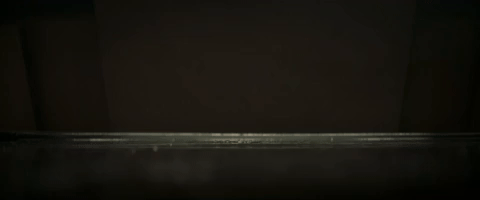
Gurney Halleck and Glossu Rabban
Let me just get this out of the way: Gurney Halleck (Josh Brolin) and Glossu Rabban (Dave Bautista) are elite goofy sci-fi names. Gurney and Glossu sound like the galaxy’s best buddy-cop duo, and if I were in charge of Warner Bros. Discovery, I would green-light that Dune spinoff immediately.
OK, back to the business at hand. Gurney is the weapons master of House Atreides, a renowned fighter who is one of the few characters of import to survive the deadly Harkonnen siege. Rabban, meanwhile, is the Baron’s nephew who spends most of Dune scowling and grunting, which is all the more intimidating when the dude is built like a former professional wrestler. I get the feeling that Gurney and Rabban are on a collision course in Part Two and that a fight between them would be the most brutal face-off between secondary characters since the Hound and the Mountain in Game of Thrones’ final season. Either that or they’ll set aside their differences to start an intergalactic detective agency. (Fingers crossed.)
Desert Power
Before House Atreides arrives on Arrakis, Leto stresses to Paul the importance of “desert power.” In essence, Leto is saying it would behoove them to learn the ways of the Fremen and their survival methods in the harsh conditions of the planet. (It’s also just really fun to say “desert power.”) The Fremen have little screen time in the first Dune, and the giant sandworms that make harvesting spice such a dangerous proposition are mostly given the Jaws treatment, where their mere presence burrowing underneath the sand strikes fear. But as Dune ends on the sight of a Fremen riding a sandworm like the world’s gnarliest chariot, it won’t be long before Paul learns what it truly means to embrace desert power.
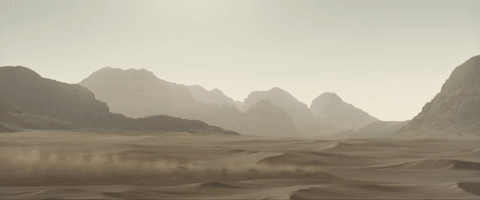
Spit Etiquette
Water is a precious resource on a desert planet like Arrakis, and the Fremen value the natural moisture that comes from our bodies so much that their stillsuits filter sweat and urine for hydration. (Somewhere, Bear Grylls vigorously nods his head in approval.) So when Stilgar (Javier Bardem), the Fremen leader of the Sietch Tabr tribe, spits in the direction of Leto Atreides upon meeting him, it’s a gesture of goodwill:
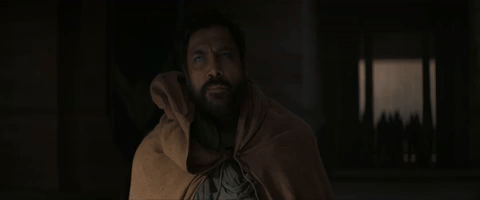
Naturally, everyone else in the room is like, “Did this guy just spit at our leader?!” before Duncan Idaho (Jason Momoa), the House Atreides sword master who spent time embedded with the Fremen, clarifies Stilgar’s intentions. These little details about the Fremen are among the most fascinating aspects of Dune—later in the film, some Fremen warriors prepare what appears to be the sci-fi equivalent of Turkish coffee by spitting on a futuristic coffee maker. (To be clear, I really want to try this saliva coffee.) I can’t wait to learn more about how Fremen communities thrive in the desert in Part Two. Until then, Stilgar, I graciously hawk a loogie in your honor.
Paul’s Trippy Visions
The reason Arrakis is such an important planet in the universe of Dune comes down to Melange, or spice, a psychedelic compound that gives its users a heightened awareness, which is necessary for faster-than-light travel across the galaxy. (Long-term exposure to spice will also turn someone’s eyes blue, which is why all the Fremen look that way.) Since much of Dune is riffing on historical conflicts within the Middle East, spice is the series’ equivalent of oil. As the Baron explains, “He who controls spice controls the universe.”
By consuming spice, it’s also possible to see into the past, present, and future. Since Paul is particularly sensitive to the effects of spice, he encounters some fascinating (and potentially prescient) visions in Dune, which tease where his story could be headed. But everything that Paul experiences shouldn’t necessarily be taken at face value: In some of these visions, he befriends Jamis (Babs Olusanmokun), a Fremen warrior who challenges Paul to a ritual duel to the death at the end of the film. In any case, it’ll be interesting to look back at Paul’s visions in Dune after watching the sequel and learn how much—or how little—these sequences telegraphed what’s to come.


